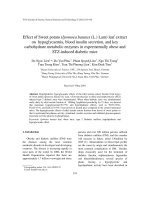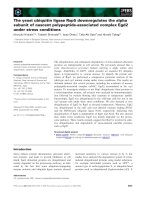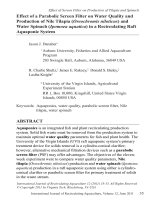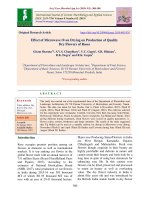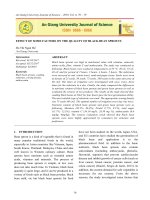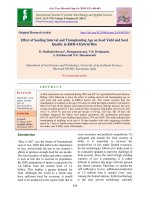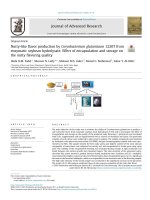Effect of pollen sources on quality characteristics of different cultivars of date palm (P. dactylifera L.) under Haryana conditions
Bạn đang xem bản rút gọn của tài liệu. Xem và tải ngay bản đầy đủ của tài liệu tại đây (159.99 KB, 7 trang )
Int.J.Curr.Microbiol.App.Sci (2017) 6(5): 71-77
International Journal of Current Microbiology and Applied Sciences
ISSN: 2319-7706 Volume 6 Number 5 (2017) pp. 71-77
Journal homepage:
Original Research Article
/>
Effect of Pollen Sources on Quality Characteristics of Different Cultivars of
Date Palm (P. dactylifera L.) under Haryana Conditions
Aashish Gupta*, R.K. Godara, A.K. Panda, Suneel Sharma and Lochan Kaushik
Department of Horticulture, CCS Haryana Agricultural University, Hisar,
Haryana (India)-125004
*Corresponding author
ABSTRACT
Keywords
Acidity, Datepalm,
Metaxenia, Pollen,
Sugars, TSS.
Article Info
Accepted:
04 April 2017
Available Online:
10 May 2017
The present study was undertaken to find out the effect of different pollinizers and
cultivars on quality traits of date palm (Phoenix dactylifera L.) at experimental orchard of
Department of Horticulture, CCS Haryana Agricultural University, Hisar during 2015.
Four different date palm cultivars (Hillawi, Zahidi, Khadrawi and Shamran) and two
pollinizers (P. dactylifera and P. sylvestris) were selected for present investigation. The
results indicated that the improvement in total soluble solids was observed with P.
sylvestris (39.40 °Brix) pollens over the pollens of P. dactylifera (34.98 °Brix). The cv.
Khadrawi (41.17 °Brix) was found superior in total soluble solid followed by cv. Shamran
(40.20 °Brix). Fruit acidity was observed nearly equal with pollens of P. dactylifera
(0.16%) and P. sylvestris (0.15%). Among the cvs, Zahidi (0.16%) and Shamran (0.16%)
recorded higher value for acidity followed by cvs. Hillawi (0.15%) and Khadrawi (0.14%).
The cv. Shamran (27.10%) was superior to all other cvs for total and reducing sugars
followed by cv. Khadrawi (24.79%). In future, these experimental results will prove very
useful for the induction of metaxenia effect in this fruit crop.
Introduction
rich in sugar, it is a good source of energy.
(USDA nutrient data base).
Phoenix has very good adaptability and a lot
of potential in arid and semi-arid zones of
Haryana, Punjab, Rajasthan and Gujarat states
(Abbas, 2014). Under Hisar conditions
summer is hot and dry but fruit maturity and
ripening coincide with the rainy season. Fruits
are generally harvested at doka/ khalal stage
and sometimes reach dang/ rutab stage. It is
one of the most delicious and nutritious fruit
containing high calorific value of about 282
kcal per 100g, 60-65% sugars, vitamins like A
(10IU), B1 (5%), B2 (6%), B3 (8%), B5 (12%),
B6 (13%) and minerals like iron (8%),
calcium (4%), potassium (14%), phosphorus
(9%), magnesium (12%), zinc (3%). Being
All species of Phoenix are dioecious with
male individuals bearing staminate flowers
and female individuals pistillate flowers. It
has been observed that some date cultivars
had better yield when pollinated with selected
males rather than with other (Djerbi, 1995).
To make pollination effective, it is better if 2
to 3 strands of male flowers are inserted
between strands of female spathe. To meet
with this problem of artificial pollination is
considered to be the most important factor
affecting fruit set and yield (Hussain et al.,
71
Int.J.Curr.Microbiol.App.Sci (2017) 6(5): 71-77
1979). Failure of effective pollination leads to
the formation of triple parthenocarpic fruits of
no economic value (Zaid and De Wet, 1999).
Although fertilization and fruit set are the two
major results of pollination, there is still
another interesting but uncommon effect
called ‘Metaxenia’: the direct influence of
pollen on the maternal tissues of the fruit
(Janick, 1979). Pollen source has been
reported to effect fruit set, ripening and
quality (AI-Obeed and Abdul-Rahman, 2002).
Most of the male palms available are of
seedling origin with great variations in their
pollen quality. These pollen grains can bring
about a lot of variations in the productivity,
size, quality and maturity of date fruits in
combination with different female cultivar.
These effects on tissue of purely maternal
origin, rather than on parts resulting from
syngamy have been described as ‘Metaxenia’
(Swingle, 1928). No work has been reported
on effect of pollinizers on fruit growth and
development of date palm fruit under Hisar
conditions. Keeping in view improving better
fruit quality in date palm cultivars the present
investigation was conducted to study the
effect of pollinizers on fruit set, physical
parameters and maturity of date palm
cultivars.
The total soluble solids were recorded with
Erma hand refractrometer (0-32 °Brix and 3260 °Brix) by putting a drop of juice and
recorded the reading. The refractrometer was
calibrated with distilled water with every use
and the values were expressed in °Brix soluble
solids. The method suggested by A.O.A.C.
(1980) was followed for estimation of
titratable acidity. The total and reducing
sugars were estimated as per the method
described by Hulme and Narain (1993).
Statistical analysis of data collected during
the study was done by applying the technique
of analysis of variance (Rai and Grover,
2006). All the statistical analysis was carried
out by using OPSTAT statistical software.
Results and Discussion
T.S.S. (°Brix)
The perusal of data given in table 1 revealed
that the total soluble solids of four date palm
cultivars as affected by pollen source differed
significantly. All cultivars significantly
differed to each other, except Khadrawi,
which was statistically at par with cultivar
Shamran. The highest total soluble solids
(39.40 °Brix) were recorded in fruits produced
from pollination of P. sylvestris as compared
to fruits which were fertilized by P.
dactylifera (34.98 °Brix). Amongst cultivars
the fruits of Khadrawi showed the highest
T.S.S. (41.17 °Brix) content which was
statistically at par with the cultivar Shamran
(40.20 °Brix), whereas, minimum total soluble
solids (31.88 °Brix) was observed from cv.
Zahidi. The interactive effect of cultivars and
pollen source was found non-significant.
However, numerically maximum total soluble
solids content of 42.97 °Brix was observed in
fruits of cultivar Khadrawi when pollens of P.
sylvestris were used. Reason behind this
might be due to differences in genetic
makeup, growth, health, vigor and spathe
characteristics (Nasir et al., 1986). The results
Materials and Methods
The present study on effect of pollen source
and cultivars on quality characteristics of date
palm was carried out in experimental orchard
of Department of Horticulture, CCS Haryana
Agricultural University, Hisar during the year
2015. The plants of selected female cultivars
(Hillawi, Zahidi, Khadrawi and Shamran)
were tagged for the pollination. Two male
pollinizer’s P. dactylifera and P. sylvestris
were used as pollen parents. The experiment
was laid out on more than 30 years old plant
in Randomized Block Design with three
replications and data was collected on bio
chemical parameters.
72
Int.J.Curr.Microbiol.App.Sci (2017) 6(5): 71-77
are partly in agreement with those obtained by
Maradi (1995), El-Kassas et al., (1996), Iqbal
and Ghafoor (2000), Marzouk et al., (2002a,
2002b), Ghaffar and Iqbal (2003) and Iqbal
(2007) who reported that total soluble solids
seemed to be influenced by type of used of
pollen.
total sugar content (32.67%) as compare to
flowers pollinated with P. dactylifera
(31.27%). Amongst cultivars the highest
percentage (34.93%) of total sugar was found
in cultivar Shamran followed by cultivars
Khadrawi and Hillawi having 34.36% and
32.67% total sugar content, respectively. The
three cultivars discussed above were
significantly differed from cultivar Zahidi
which have least total sugar content (25.91%).
Interactive effect of pollen sources and
cultivars were non-significant. However
maximum total sugar (36.62%) was observed
in cultivar Shamran pollinated with P.
sylvestris pollens. Minimum total sugar
percentage (25.35%) was recorded in cultivar
Zahidi when pollens of P. dactylifera were
used. Reasons behind this might be due to
activities of the enzymes system initiated by
the metaxenic effect and later on passed into
extra cellular sites, get dissolve readily into
water and invert the sugar. Similarly, the
hydrolytic
enzymes,
such
as
polygalacturonase and cellulose may also be
involved in these biochemical changes by
solubilizing the pectin and cellulose of cell
wall (Hasegawa and Smolensky, 1971;
Ghnaim and Al- Muhtaseb, 2006). The effect
of pollen source on the physiology and
biosynthesis of sugars is still not fully clear
(Helail and El-Kholey, 2000; El-Ashry, 2009;
Omar et al., 2014).
Acidity (%)
Data pertaining to fruit acidity as influenced
by the two pollen parents is presented in table
2. The perusal of data show that the pollen
sources as well as cultivars did not differed
significantly. However, the titratable acidity
was more in the fruits which were pollinated
with the P. dactylifera (0.16%) pollens as
compared to the fruits pollinated by P.
sylvestris (0.15%) pollens. These results are
in harmony with Musa (1981), Mawlood
(1980) and Farag et al., (2012).
Total sugar (%)
The data on total sugar of fruits as affected by
pollinizers is given in table 3. It can be clearly
seen that the pollen sources showed the non
significant results, while the cultivars Hillawi,
Khadrawi and Shamran differed significantly
to the cultivar Zahidi. There was no
significant difference among these three
cultivars. The flowers treated with pollens of
P. sylvestris recorded the significantly higher
Table.1 Effect of pollinizers on T.S.S. (°Brix) in cvs. of date palm
Pollinizers
Cultivars
Mean
Hillawi
Zahidi
Khadrawi
Shamran
P. dactylifera
32.47
30.20
39.37
37.90
34.98
P. sylvestris
38.57
33.57
42.97
42.50
39.40
Mean
35.52
31.88
41.17
40.20
CD (P=0.05)
Pollinizers = 0.99, Cultivars = 1.39, Pollinizers × Cultivars = NS
73
Int.J.Curr.Microbiol.App.Sci (2017) 6(5): 71-77
Table.2 Effect of pollinizers on acidity (%) in cvs. of date palm
Cultivars
Pollinizers
Mean
Hillawi
Zahidi
Khadrawi
Shamran
P. dactylifera
0.17
0.18
0.13
0.15
0.16
P. sylvestris
0.14
0.15
0.14
0.17
0.15
Mean
0.15
0.16
0.14
0.16
CD (P=0.05)
Pollinizers = NS, Cultivars = NS, Pollinizers × Cultivars = NS
Table.3 Effect of pollinizers on total sugar (%) in cvs. of date palm
Cultivars
Pollinizers
Mean
Hillawi
Zahidi
Khadrawi
Shamran
P. dactylifera
32.11
25.35
34.36
33.24
31.27
P. sylvestris
33.24
26.48
34.36
36.62
32.67
Mean
32.67
25.91
34.36
34.93
CD (P=0.05)
Pollinizers = NS, Cultivars = 2.91, Pollinizers × Cultivars = NS
Table.4 Effect of pollinizers on reducing sugars (%) in cvs. of date palm
Cultivars
Pollinizers
Mean
Hillawi
Zahidi
Khadrawi
Shamran
P. dactylifera
20.00
18.88
25.07
25.64
22.40
P. sylvestris
24.51
19.44
24.51
28.55
24.25
Mean
22.26
19.16
24.79
27.10
CD (P=0.05)
Pollinizers = NS, Cultivars = 2.84, Pollinizers × Cultivars = NS
74
Int.J.Curr.Microbiol.App.Sci (2017) 6(5): 71-77
Table.5 Effect of pollinizers on non reducing sugars (%) in cvs. of date palm
Cultivars
Pollinizers
Mean
Hillawi
Zahidi
Khadrawi
Shamran
P. dactylifera
12.11
6.47
9.29
7.60
8.87
P. sylvestris
8.73
7.04
9.85
8.06
8.42
Mean
10.42
6.76
9.57
7.83
CD (P=0.05)
Pollinizers = NS, Cultivars = NS, Pollinizers × Cultivars = NS
polygalacturonase and cellulose may also be
involved in these biochemical changes by
solubilizing the pectin and cellulose of cell
wall (Hasegawa and Smolensky, 1971;
Ghnaim and Al- Muhtaseb, 2006). The effect
of pollen source on the physiology and
biosynthesis of sugars is still not fully clear
(Helail and El-Kholey, 2000; El-Ashry, 2009;
Omar et al., 2014).
Reducing sugars (%)
The perusal of data given in table 4 revealed
that the reducing sugars did not differ
significantly by pollen parents but among
cultivars significant difference was recorded,
whereas, the cultivars Khadrawi and Hillawi
were at par with each other. The pollen source
showed non-significant effect on reducing
sugars. However higher reducing sugars
(24.25%) were observed in the fruits which
were pollinated with pollen of P. sylvestris
and with P. dactylifera pollens gave lower
(22.40%) reducing sugars. Amongst the
cultivars the highest reducing sugars
(27.10%) were recorded in cultivar Shamran
which was significantly differed from
cultivars i.e. Hillawi (22.26%) and Zahidi
(19.16%). The cultivars Hillawi and
Khadrawi were statistically at par with each
other. The cumulative effect of cultivars and
pollen sources on reducing sugars showed
non-significant effect. However, numerically
the maximum reducing sugars content
(28.55%) were observed in the fruits of
cultivar Shamran pollinated with P. sylvestris
pollens. The minimum reducing sugars
(18.88%) were found in cultivar Zahidi when
pollinated with pollens of P. dactylifera. This
might be due to activities of the enzymes
system initiated by the metaxenic effect and
other biochemical changes in the fruit.
Similarly the hydrolytic enzymes, such as
Non-reducing sugars (%)
Data pertaining to non-reducing sugars as
affected by the pollen sources on date palm
cvs. is presented in table 5. The perusal of
data showed that effect of pollen sources as
well as cultivars on non reducing sugars did
not differ significantly. However, the non
reducing sugars content was higher in the
flowers fertilized with P. dactylifera pollens
(8.87%) than the flowers pollinated with P.
sylvestris pollens (8.42%). Amongst the
cultivars highest percentage (10.42%) of non
reducing sugars were observed in cv. Hillawi
which was followed by cultivars Khadrawi,
Shamran and Zahidi having reducing sugar
content of 9.57 per cent, 7.83 per cent and
6.76 per cent, respectively. There was no
effect of cvs. on percentage of non reducing
sugar content. The non significant effect of
pollen sources and cultivars on percent non
reducing sugar was observed. Numerically
highest non reducing sugars were recorded in
75
Int.J.Curr.Microbiol.App.Sci (2017) 6(5): 71-77
cultivar Hillawi (12.11%) when pollens of P.
dactylifera were used. The same pollen source
gave the lowest (6.47%) content of non
reducing sugars in cultivar Zahidi. These
results were in close agreement with the
finding of Shafique et al., (2011).
metaxenic influences of used pollinator.
American-Eurasian J. Agric. Environ.
Sci., 12(7): 842-855.
Ghaffar, A. and Iqbal, M. 2003. Effect of
male pollinizers on fruit setting and
yield of cv. Zahidi and Dhakki under
the agro climatic conditions of D.I.
Khan.M.Sc..Hons.) thesis, Dept. of
Hort., Agriculture Fac., Gomal Univ.,
D.I. Khan.
Ghnaim, D.H. and Al- Muhtaseb, J.A. 2006.
Effect of pollen source on yield, quality
and maturity of ‘Mejhool’ date palm.
Jordan J. Agri. Sci., 2(1): 8-15.
Hasegawa, S., Smolensky, D.C. 1971.
Cellulase in dates and its role in fruit
softening. J. Food Sci., 36(6): 966-967.
Helail, B.M. and El-Kholey, L.A. 2000.
Effect of pollen grain sources on palm
fruiting and date quality of Hallawy and
Khadrawy date palms. Annals of Agri.
Sci., 38(1): 479-494.
Hulme, A.C. and Narain, R. 1993. The
ferrycynide method for determination of
reducing sugars. A modification of
Hegedom-Jenson Hanes Technique.
Biochem. J., 25: 1051-1061.
Hussain, F., Mustafa, S. and Mahmoud, I.
1979.
The
direct
effect
of
pollen.Metaxenia)
on
fruit
characteristics of dates grown in Saudi
Arabia. Saudi Biol. Soc. Proceedings,
Third Conference, Al-Hassa, pp. 96-78.
Iqbal, M. and Ghafoor, A. 2000. Study on
fruit setting of some date palm cultivars
by natural way of pollination,
unpublished data.
Iqbal, M. 2007. Effect of various dactylifera
males and pollination innovation in fruit
setting and yield of cv. Dhakki. Ph.D.
Dept. of Hort., Fac. Agric., Gomal
Univ., D.I. Khan- NWFP-Pakistan.
Janick, J. 1979. Hort. Sci., 3rd edn. W.H.
Freeman and Company, San Francisco.
pp. 604.1979
Maradi, A. 1995. Effect of pollination and
From the present study it can be concluded
the pollinizer P. sylvestris showed metaxenic
effect for TSS only. The cultivar Khadrawi
showed maximum TSS compared to the other
cultivars. The pollen source doesn’t have any
significant effect on acidity, total sugar,
reducing and non reducing sugars.
References
Abbas, R. 2014. Comparative analysis of date
palm culture in India and Pakistan.
Daily Times (Pakistan).
AI-Obeed, R.S. and Abdul-Rahman, A.O.
2002. Compatibility relationships within
and between ten date palm cultivars.
Phoenix dactylifera L. I-Fruit set and
yield. J. Adv. Agri. Res., 7(4): 809- 820.
A.O.A.C. 1980. Official Methods of Analysis.
Association of Official Analytical
Chemists, 13th edition, Washington,
D.C. USA.
Djerbi, M. 1995. Précis de Phoeniciculture.
FAO, Rome. pp. 192.
El-Ashry, H. 2009. Fruit quality and
hormonal constituents of zaghloul date
palm fruits in relation to metaxenic
influences of used pollinator. Ph.D.
thesis, Hort. Dept., Fac. of Agric.,
Alexandria University, Egypt.
El-Kassas, S.E., El-Salhy, A.M. and Abdella,
A.Y. 1996. Efficiency of pollination of
Zaghloul and Samany date palms with
male strands at certain degrees of
drying. Assiut J. Agric. Sci., 27(2): 3745.
Farag, K.M., Elsabagh, A.S. and El-Ashry,
H.A. 2012. Fruit characteristics of
"Zaghloul" date palm in relation to
76
Int.J.Curr.Microbiol.App.Sci (2017) 6(5): 71-77
pollen dilution on some chemical
constituent of fruit development. Hort.
Abst., 60(2): p. 361, abst. no. 10874.
Marzouk, H.M., El-Salhy, M. and Hassan,
R.A. 2002. Effect of male type and
receptivity of pistillate flowers on fruit
set, yield and some physical fruit
properties of Zaghloul and Samany date
palm cultivars. Proc. of Minia 1st conf.
for Agric. and Env. Sci., Minia Egypt.
March 25-28, p.1013-1023.2002a
Marzouk, H.M., El-Salhy, M. and Hassan,
R.A. 2002b. Effect of pollination on
fruit set, yield and fruit quality of
Zaghloul and Samany date palm
cultivars. Proc. of Minia 1st conf. for
Agric. and Env. Sci., Minia Egypt,
March 25-28, p. 983-997.
Mawlood, E.A. 1980. Physiological studies
on fruits development of Samani and
Zaghloul date palm cultivars. Ph.D.
thesis. Fac. Agric., Cairo university.
Musa, I.A. 1981. Evaluation of studies of
some seedling date palms grown at
Ismailia province, M.Sc. thesis. Fac.
Agric., Zagazig Univ., Egypt.
Nasir, T.A., Shaheen, M.A. and Bacha, M.A.
1986. Evaluation of seedling male palm
used in pollination in the central region
of Saudi Arabia. Date Palm J., 4(2):
163-173.
Omar, A.Kh., Al-Obeed R.S. and Ahmed,
M.A. 2014. Metaxenic effects as related
to male palm.Phoenix dactylifera and
Phoenix canariensis) yield and quality
of Khalas fruit. J. Food, Agri. Environ.,
12(2): 523-525.
Rai, L. and Grover, D. 2006. Manual on
Designing and Analysis of Agricultural
data. Chaudhary Charan Singh Haryana
Agricultural University, Hisar, pp. 112138.
Shafique, M., Khan, S.A., Malik, U.A.,
Shahid, M., Rajwana, A.I., Saleem,
A.B., Amin, M. and Ahmad, I. 2011.
Influence of pollen source and
pollination frequency on fruit drop,
yield and quality of date palm.Phoenix
dactylifera L.) cv. Dhakki. Pak. J. Bot.,
43(2): 831-839.
Swingle, W.T. 1928. Metaxenia in date palm,
possibly a hormone action by the
embryo or endosperm. J. Heredity,
19(6): 257-268.
USDA
nutrient
data
base.
/>#Nutritional_value
Zaid, A. and De Wet, P.F. 1999. Pollination
and Bunch Management, Date palm
cultivation, FAO, Rome, pp. 144-158.
How to cite this article:
Aashish Gupta, R.K. Godara, A.K. Panda, Suneel Sharma and Lochan Kaushik. 2017. Effect of
Pollen Sources on Quality Characteristics of Different Cultivars of Date Palm (P. dactylifera
L.) under Haryana Conditions. Int.J.Curr.Microbiol.App.Sci. 6(5): 71-77.
doi: />
77
